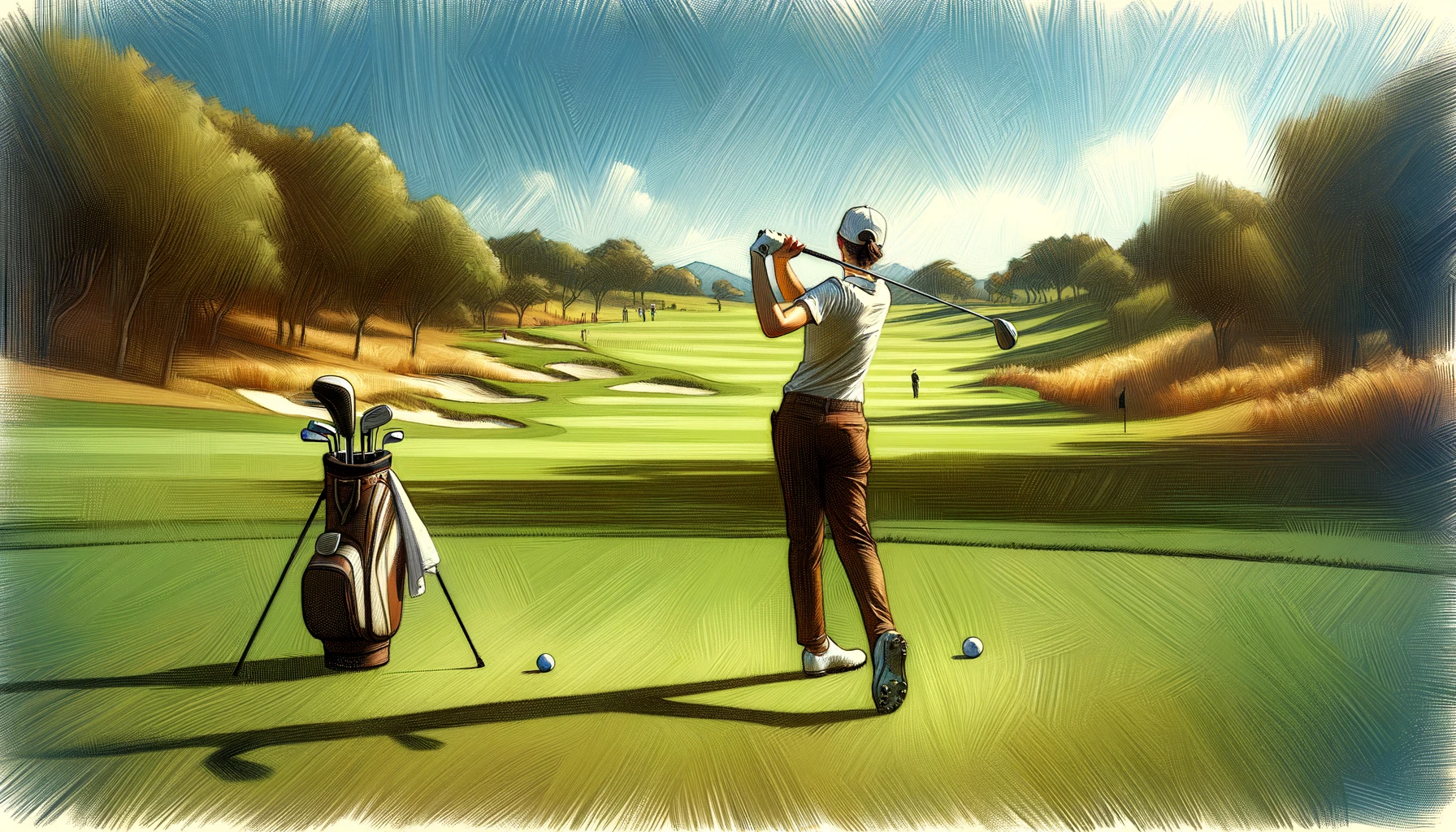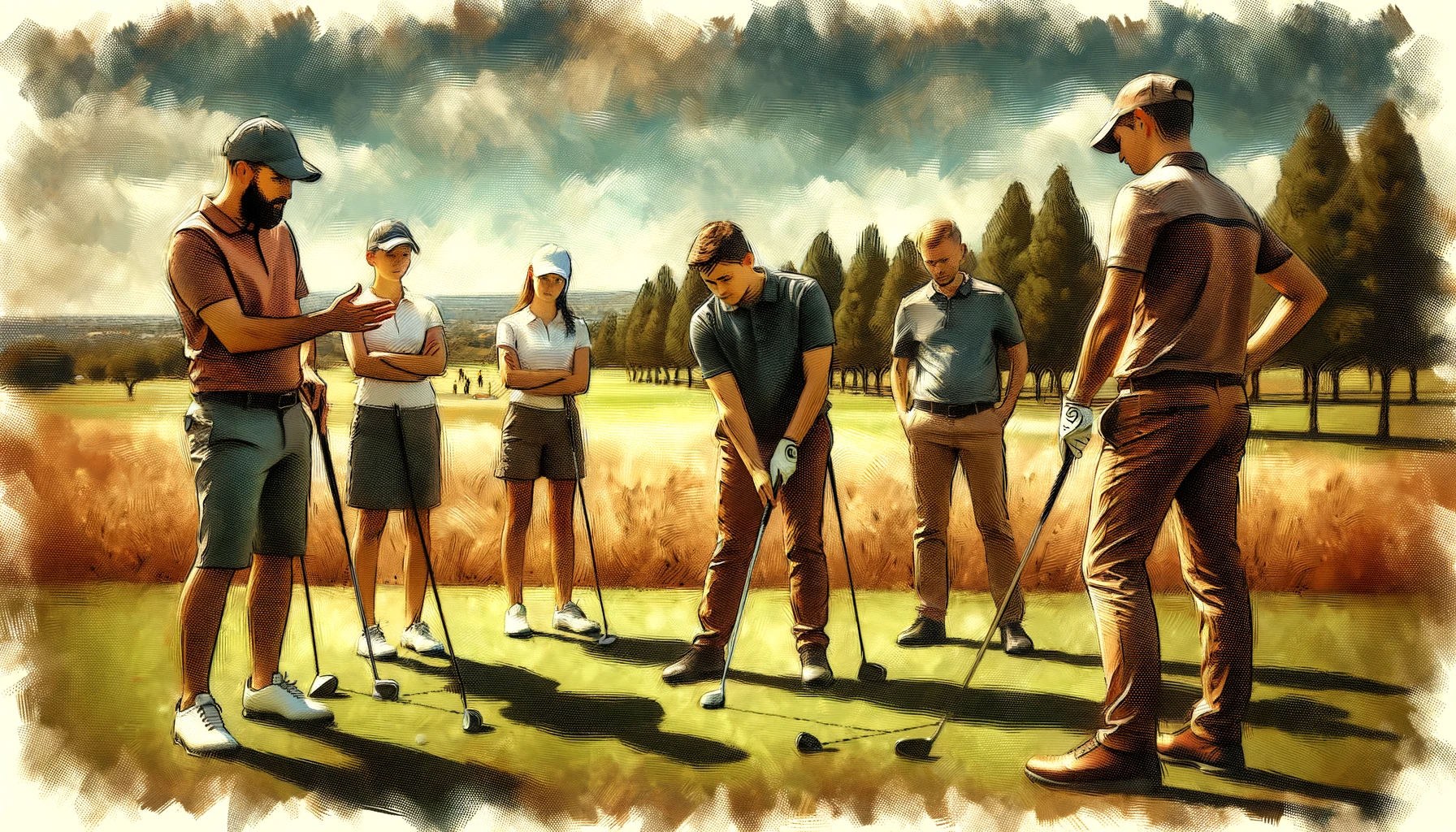- Home
- Beginner Golf
- How to Hit a Golf Ball for Beginners
Mastering the Basics: How to Hit a Golf Ball for Beginners and Impress Your Friends
Struggling with your golf game and feeling frustrated? Discover how to hit a golf ball for beginners with our comprehensive guide that covers everything from stance to swing. With clear instructions, practical tips, and answers to common questions, you’ll be hitting the ball like a pro in no time. Check out our key takeaways and FAQ section for quick solutions and tips to improve your game fast.
Are you tired of feeling embarrassed on the golf course? Do your shots often veer off target, leaving you frustrated and ready to quit? I’ve been there too, struggling with the basics and feeling the sting of every missed shot.
Imagine stepping up to the first tee, your buddies watching, and instead of nailing a perfect drive, you slice the ball into the trees. It’s nerve-shattering and instantly traumatizing, isn’t it? Every misstep feels like it drags you further from your dream of mastering the game. The complexity of golf can make you feel overwhelmed, almost ready to give up.
But here’s the good news: mastering how to hit a golf ball can be simple and fun with the right guidance. In this comprehensive guide, I'll walk you through the basics with clear, step-by-step instructions, insider tips, and personal anecdotes that will transform your game. Together, we’ll tackle the stance, grip, swing, and more, turning you from a frustrated novice into a confident golfer.
 Beginner golfer hitting the perfect drive on a sunny day
Beginner golfer hitting the perfect drive on a sunny dayPerfecting How to Hit a Golf Ball for Beginners: Step-by-Step
When I first picked up a golf club, I was excited but clueless. Like many beginners, I struggled with the basics—my stance was off, my grip felt awkward, and my swings were inconsistent. Every time I stepped onto the course, I felt overwhelmed and embarrassed. I wanted to enjoy the game and impress my friends, but my lack of skill held me back.
Determined to improve, I embarked on a journey to master the fundamentals of golf. I spent countless hours watching tutorials, reading articles, and practicing at the driving range. Despite my efforts, progress was slow, and frustration often set in. I needed a breakthrough, a way to make the learning process more efficient and enjoyable.
One day, I stumbled upon a comprehensive guide that promised to simplify the process of learning how to hit a golf ball for beginners. The guide broke down each aspect of the game into easy-to-understand steps, complete with practical tips and common mistakes to avoid. It was exactly what I needed—a structured approach that catered to my level of experience.
The framework laid out in the guide was straightforward and effective. It started with mastering the stance, ensuring a stable foundation for every swing. Next, it focused on the grip, teaching me how to hold the club properly for maximum control. The swing was broken down into manageable phases—takeaway, backswing, downswing, and follow-through—each explained in detail. The guide also included tips for practicing effectively and overcoming common mistakes.
With this new framework, my game began to transform. I started hitting the ball more consistently and accurately. My confidence grew with each successful swing. Not only did I begin to enjoy the game more, but I also started to impress my friends on the course. The embarrassment I once felt was replaced with a sense of accomplishment and pride. I had finally cracked the code to hitting a golf ball as a beginner, and it changed my golfing experience forever.
"Success is no accident. It is hard work, perseverance, learning, studying, sacrifice and most of all, love of what you are doing or learning to do." - Pelé
The Basics of Hitting a Golf Ball
Stance
Your stance is the foundation of your golf swing. Getting it right is crucial to hitting the ball accurately and consistently. Here’s how to nail it:
- Position Your Feet: Start with your feet shoulder-width apart. This gives you a stable base. If you're using a driver, widen your stance slightly. For irons, keep your feet shoulder-width apart or slightly narrower.
- Align with the Target: Your feet should be parallel to the target line, which is the imaginary line running from the ball to your target.
- Distribute Your Weight: Keep your weight evenly distributed on the balls of your feet. Avoid leaning too far forward or backward.
Remember, a solid stance helps you stay balanced throughout your swing, leading to better control and power.
Grip
Your grip on the club can make or break your swing. It’s your only connection to the club, so getting it right is essential.
- Choose Your Grip Style: There are three main grips: the interlocking, the overlapping, and the baseball grip. Beginners often find the baseball grip easiest to start with.
- Position Your Hands: Hold the club in your fingers, not your palms. Place your lead hand (left hand for right-handed golfers) at the top of the grip. Your trail hand should wrap around the lead hand, with both thumbs pointing down the shaft.
A proper grip ensures you can control the clubface, which directly affects the ball’s flight.
Swing
The golf swing is a fluid motion that requires practice and coordination. Breaking it down into steps can help simplify the process.
1. Takeaway: Start the swing by moving the club back smoothly, keeping your arms straight and rotating your shoulders. The club should move back in one piece, not just with your hands.
2. Backswing: As you continue the backswing, hinge your wrists and turn your shoulders fully. Your back should face the target at the top of the backswing.
3. Downswing: Initiate the downswing with your lower body. Shift your weight to your front foot and rotate your hips toward the target. This unwinding motion generates power.
4. Follow-Through: After striking the ball, continue your swing with a full follow-through. Your club should end up pointing towards the target, and your body should be facing it.
A smooth, controlled swing, rather than a powerful one, often leads to better results.
Follow-Through and Finish
The follow-through and finish are critical parts of the swing that many beginners overlook. They ensure you complete the swing properly, maintaining balance and direction.
- Follow-Through: Keep your head down and continue the swing motion after hitting the ball. Your body should rotate fully, and the club should end up over your shoulder.
- Finish: Your body should be fully rotated towards the target, with most of your weight on your front foot. This position indicates a complete and balanced swing.
By focusing on the follow-through and finish, you’ll develop muscle memory for a smooth, complete swing every time.
Common Mistakes to Avoid
Many beginners make the same mistakes, which can be easily corrected with practice and awareness.
- Lifting the Head Too Early: Keep your head down until after you’ve struck the ball to maintain balance and direction.
- Gripping the Club Too Tightly: A death grip restricts fluid motion. Keep your grip firm but relaxed.
- Over-Swinging: Focus on a smooth, controlled swing instead of trying to hit the ball as hard as possible.
Overcoming Common Mistakes
Practice Makes Perfect
We all know that practice is essential, but the quality of your practice matters just as much as the quantity. Here’s how you can make the most out of your practice sessions:
- Focus on Fundamentals: Spend time perfecting your stance, grip, and swing. These are the building blocks of a great golf game.
- Use Different Clubs: Practice with various clubs to understand how each one affects the ball’s trajectory and distance. This will help you become a more versatile golfer.
- Create a Routine: Establish a consistent practice routine that you follow regularly. This helps build muscle memory and improves your overall performance.
I remember when I first started golfing, I was making every rookie mistake in the book. My grip was too tight, I lifted my head too early, and my stance was all wrong. One day at the driving range, an experienced golfer named Mike noticed my struggles. He walked over and offered some friendly advice. Mike showed me how to relax my grip and keep my head down during the swing. He even demonstrated the proper stance. That day, my game changed dramatically. With consistent practice and Mike’s tips, I started hitting the ball straighter and further. It was a game-changer!
 Focused beginner golfer practicing at sunset
Focused beginner golfer practicing at sunsetFrequently Asked Questions (FAQs)
What is the best way to hit a golf ball for beginners?
What is the best way to hit a golf ball for beginners?
The best way to hit a golf ball for beginners is to focus on the basics: a proper stance, grip, and a smooth swing. Taking lessons from a professional can provide personalized feedback and accelerate your learning process.
What is the most important part of the golf swing?
What is the most important part of the golf swing?
While all parts of the swing are important, the grip is often considered the most crucial. It’s your only physical connection to the club and directly influences the clubface’s direction, which affects the ball’s flight.
How do you hit a golf ball straight every time?
How do you hit a golf ball straight every time?
Consistency is key to hitting the ball straight. Focus on maintaining a proper stance, a relaxed grip, and a smooth swing. Regular practice and possibly taking lessons from a professional can greatly improve your accuracy.
How do you hit a golf ball with irons?
How do you hit a golf ball with irons?
Hitting a golf ball with irons requires a slightly different technique than using a driver. Your stance should be shoulder-width apart, with the ball positioned closer to your lead foot. Focus on a smooth, controlled swing and follow through fully.
How do you hit a golf ball with a driver?
How do you hit a golf ball with a driver?
When hitting with a driver, widen your stance slightly and position the ball further up in your stance, near your lead foot. Use a sweeping motion with a smooth swing, aiming to hit the ball on the upswing for maximum distance.
Conclusion
Mastering the art of hitting a golf ball takes time, patience, and practice. By focusing on the fundamentals such as stance, grip, and swing, and by avoiding common mistakes, you can significantly improve your game. Remember, every golfer started as a beginner, making the same mistakes you might be making now. But with consistent practice and a willingness to learn, you can transform your game and impress your friends on the course.
Golf is not just about hitting the ball; it's about enjoying the process of learning and improving. So, get out there, practice with purpose, and have fun. And don't forget to share your progress with fellow golfers—after all, the journey is just as important as the destination.
Are you ready to take your golf game to the next level? Start implementing these tips and techniques today and see the difference they make. Happy golfing!
 Beginner golfers receiving expert tips during a lesson
Beginner golfers receiving expert tips during a lessonCore Actionable Takeaways for How to Hit a Golf Ball for Beginners
1. Perfect Your Stance:
- Position your feet shoulder-width apart to create a stable base.
- Align your feet parallel to the target line to ensure accuracy.
- Distribute your weight evenly on the balls of your feet to maintain balance.
2. Master Your Grip:
- Choose a grip style that feels comfortable: interlocking, overlapping, or baseball.
- Hold the club in your fingers, not your palms, to enhance control.
- Ensure both thumbs point down the shaft for proper alignment.
3. Execute a Smooth Swing:
- Takeaway: Move the club back smoothly, keeping arms straight and rotating shoulders.
- Backswing: Hinge your wrists and turn your shoulders fully, keeping your back facing the target.
- Downswing: Initiate with your lower body, shift weight to the front foot, and rotate hips toward the target.
- Follow-Through: Continue the motion after striking the ball, ending with the club over your shoulder.
4. Avoid Common Mistakes:
- Keep your head down until after striking the ball to maintain direction.
- Maintain a relaxed grip to ensure fluid motion.
- Focus on a smooth, controlled swing rather than power to improve consistency.
5. Effective Practice Tips:
- Focus on the fundamentals: stance, grip, and swing.
- Practice with different clubs to understand their effects on the ball’s trajectory and distance.
- Establish a consistent practice routine to build muscle memory and improve performance.
Are you ready to transform your golf game and finally master how to hit a golf ball for beginners?











